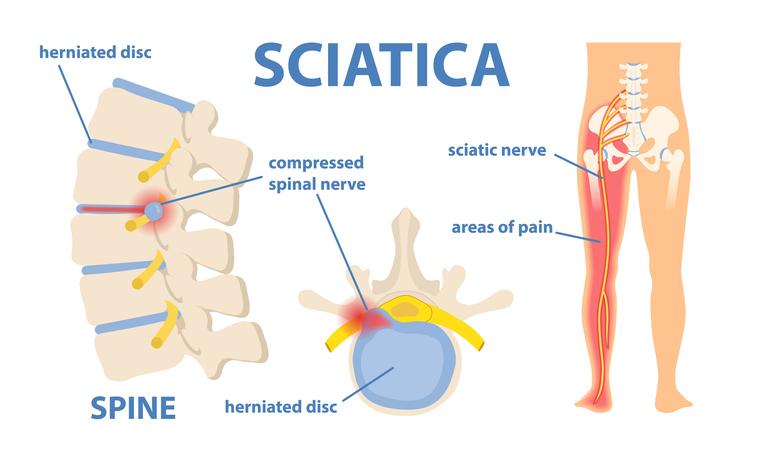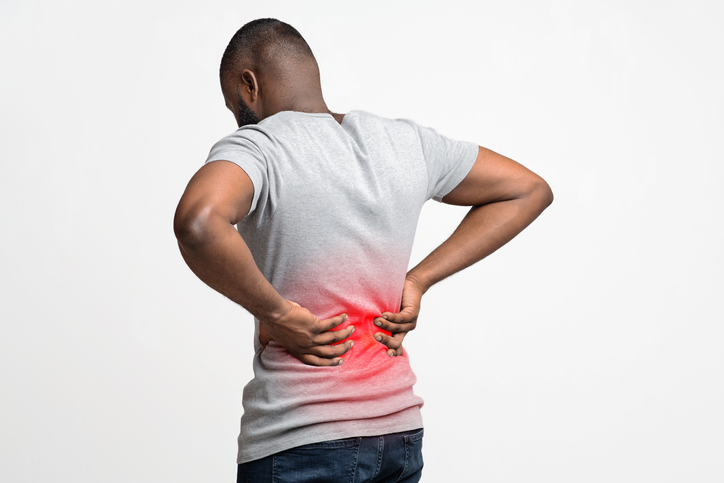Pain
What Is Sciatica?

Sciatica, or sciatic nerve pain, is pain that occurs when the sciatic nerve root in the low back is compressed, irritated, or inflamed. Sciatic nerve pain radiates from the low back to the buttock and down one leg. It most commonly occurs due to herniated discs, bone spurs, or spinal stenosis.
Sciatica is categorized according to the duration of symptoms (acute or chronic sciatica). It typically affects only one side of the body; however, although rare, it can affect both sides of the lower extremities at the same time (bilateral sciatica).
What is the sciatic nerve?
The sciatic nerve is the longest and largest nerve in the body with a diameter approximately the size of a penny. It is composed of two nerve roots that originate from the lumbar (low back) spine and three nerve roots that originate from the sacrum (bottom of the spine). These five nerve roots unite and form a sciatic nerve on each side of the body. Each sciatic nerve runs from the low back into the buttock and down one leg.
Symptoms
Sciatica nerve pain can be mildly irritating, severe, or debilitating; however, most cases resolve with self-care within a few weeks. Symptoms of sciatica include the following:
- Pain
Sciatic pain involves burning, sharp, shooting pain that radiates from the low back through the buttock and down the back of the thigh and calf. Pain often worsens with movement, twisting, bending down, or coughing. Sciatica is a common symptom of lumbar radiculopathy. Radiculopathy is the medical term for symptoms caused by irritation or compression of one or more spinal nerve roots. - Numbness or weakness
Tingling, numbness, or weakness may occur in the low back and the affected leg and foot. Muscle weakness may also occur, resulting in difficulty bending the knee or lifting the foot. - Symptoms on one side
Both legs are rarely affected at the same time. Only one side of the lower extremities is typically affected. - Posture-related symptoms
Changes in posture (e.g., standing, bending, twisting, lying down, sitting, etc.) may worsen or relieve pain. Pain may be constant or increase when lying down; therefore, lying on either the back or side with a pillow under or between the legs may help relieve pain. - Bowel or bladder dysfunction
In severe cases of sciatica, loss of bowel or bladder control may occur. This requires immediate medical attention.
When to see a doctor
A health care professional should be consulted if sciatica pain lasts longer than a week or becomes progressively worse. Medical care is also needed in the following cases:
- Sudden and severe pain in the low back and leg accompanied by muscle weakness
- Pain due to a traumatic injury, such as a traffic accident
- Loss of control of the bladder or bowels
Causes
Causes of sciatica include, but are not limited to, the following:
- Herniated or slipped discs
The most common cause of sciatica is a herniated or slipped disc. As a disc naturally degenerates with age, it can herniate, causing irritation or compression of the sciatic nerve. - Degenerative disc disease
Degenerative disc disease is a condition of the spine in which one or more of the discs between the vertebrae cause neck or back pain. - Spinal stenosis
Spinal stenosis is a narrowing of the spinal canal, which can compress the sciatic nerve. - Spondylolisthesis
Spondylolisthesis is a medical condition that primarily affects the low back and can lead to nerve compression. - Osteoarthritis
Osteoarthritis involves the gradual breakdown of cartilage in one or more joints. The bones in the joint eventually rub together and can pinch the sciatic nerve. - Bone spurs
Bone spurs are often the result of the progression of osteoarthritis. As the overgrowth of bones form, jagged edges can place pressure on sciatic nerve roots. - Piriformis syndrome
Piriformis syndrome is a rare neuromuscular disorder. The piriformis muscle runs alongside the sciatic nerve. This muscle can become irritated or spasm, causing pressure on the sciatic nerve. - Vertebral fracture
A vertebral fracture is a fracture in any of the 33 vertebrae that make up the spinal column and may result in compression of the sciatic nerve. - Tumors
A tumor in the lumbar spinal canal can compress the sciatic nerve. - Injury
Any type of injury to the lumbar spine or the sciatic nerve can cause sciatica. - Cauda equina syndrome
Although rare, cauda equina is a serious condition that requires immediate medical care to prevent permanent complications. It occurs from compression of the nerve bundle below the end of the spinal cord called the cauda equina. Symptoms include pain in the low back, buttocks, and legs; numbness around the anus; difficulty walking, and loss of bladder or bowel control.
Risk factors
Factors that increase the risk of sciatica include the following:
- Between the ages of 20 and 50 (The population most likely to have herniated discs.)
- Aging (Bone spurs are more likely as people age.)
- Obesity
- Physical labor (e.g., a job that requires heavy lifting, twisting, or driving for long periods)
- Sedentary lifestyle
- Diabetes
- Osteoarthritis
- Tobacco use
- Injury to the spine or low back
- Weak core strength
- Poor posture


















